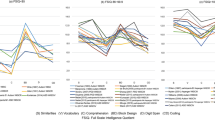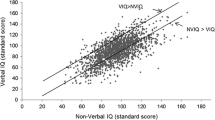Abstract
Individuals with autism spectrum disorder (ASD) are hypothesized to exhibit relative strengths in verbal and non-verbal reasoning and weaknesses in working memory and speed of information processing. The purpose of the present investigation was to determine the degree to which this cognitive profile as measured by the Wechsler Intelligence Scale for Children—Fourth Edition (WISC-IV; Wechsler 2003a) cognitive proficiency index (CPI; measure of working memory and processing speed) and general ability index (GAI; measure of verbal and non-verbal reasoning) could accurately distinguish between a referred sample of 79 school-aged students diagnosed with ASD and two non-clinical comparison groups: (a) 2200 children in the WISC-IV standardization sample and (b) 216 school-aged students referred for psychoeducational testing whose school-based evaluations did not result in a diagnosis. Results indicated that the ASD sample exhibited significantly lower mean scores on the CPI when compared to the two control groups. However, diagnostic utility statistics indicated that a randomly selected participant from the ASD subgroup would exhibit a larger difference between the GAI and CPI than a randomly selected participant from the two control groups 51.9–66.0% of the time. Consequently, the GAI > CPI cognitive score profile exhibits low diagnostic accuracy for individuals with ASD. Psychologists who work in applied settings are cautioned against using group trends to guide decision-making for individual clients.



Similar content being viewed by others
Notes
Use of the term autism spectrum disorder (ASD) herein refers to the current definition in the Diagnostic and Statistical Manual of Mental Disorders—Fifth Edition (2013) that includes other conditions formerly referred to as pervasive developmental disorders, such as Asperger’s disorder and pervasive developmental disorder-not otherwise specified, unless otherwise noted.
Standardization data from the Wechsler Intelligence Scale for Children, Fourth Edition (WISC-IV). Copyright © 2003 NCS Pearson, Inc. Used with permission. All rights reserved.
References
Arizona Administrative Code 7 A.A.C. § 2-4 n.d..
Barnhill, G., Hagiwara, T., Myles, B. S., & Simpson, R. L. (2000). Asperger syndrome: A study of the cognitive profiles of 37 children and adolescents. Focus on Autism and Other Developmental Disabilities, 15, 146–153.
Braden, J. P. (2013). Psychological assessment in school settings. In J. A. Naglieri & J. R. Graham (Eds.), Handbook of psychology: Assessment psychology (Vol. 10, 2nd ed., pp. 261–290). Hoboken: John Wiley & Sons, Inc..
Calhoun, S. L., & Mayes, S. D. (2005). Processing speed in children with clinical disorders. Psychology in the Schools, 42, 333–343. https://doi.org/10.1002/pits.20067
Cederlund, M., & Gillberg, C. (2004). One hundred males with Asperger syndrome: a clinical study of background and associated factors. Developmental Medicine and Child Neurology, 46, 652–660.
Centers for Disease Control and Prevention. (2014). Prevalence of autism spectrum disorder among children aged 8 years—autism and developmental disabilities monitoring network, 11 sites, United States, 2010 (Surveillance Summaries No. 63–2). Atlanta: U.S. Department of Health and Human Services.
Cohen, J. (1988). Statistical power analysis for the behavioral sciences—second edition. Mahwah: Lawrence Erlbaum & Associates.
Cotter, K., & Peipert, J. F. (2005). Can you handle the truth (and know it when you see it)? Understanding sensitivity, specificity, predictive values, and ROC curves. Journal of Minimally Invasive Gynecology, 12, 385–390. https://doi.org/10.1016/j.jmig.2005.05.021
Devena, S. E., & Watkins, M. W. (2012). Diagnostic utility of WISC-IV general abilities index and cognitive proficiency index difference scores among children with ADHD. Journal of Applied School Psychology, 28, 133–154. https://doi.org/10.1080/15377903.2012.669743
Doherty, M. E., Mynatt, C. R., Tweney, R. D., & Schiavo, M. D. (1979). Pseudodiagnosticity. Acta Psychologica, 43, 111–121.
Fawcett, T. (2006). An introduction to ROC analysis. Pattern Recognition Letters, 2, 861–874. https://doi.org/10.1016/j.patrec.2005.10.010
Flanagan, D. P., & Kaufman, A. S. (2004). Essentials of WISC-IV assessment. Hoboken: Wiley.
Flanagan, D. P., Ortiz, S. O., & Alfonso, V. C. (2013). Essentials of cross-battery assessment—third edition. Hoboken: John Wiley & Sons.
Foley-Nicpon, M., Assouline, S. G., & Stinson, R. D. (2012). Cognitive and academic distinctions between gifted students with autism and asperger syndrome. Gifted Child Quarterly, 56, 77–89. https://doi.org/10.1177/0016986211433199
Hajian-Tilaki, K. O., Hanley, J. A., Joseph, L., & Collet, J. P. (1997). A comparison of parametric and nonparametric approaches to ROC analysis of quantitative diagnostic tests. Decision Making, 17, 94–102.
Happe, F. G. E. (1994). Wechsler IQ profile and theory of mind in autism: a research note. Journal of Child Psychology and Psychiatry, 35, 1461–1471.
Individuals with Disabilities Education Improvement Act. (2004). Public Law 108–446, 108th Cong., 118 Stat. 2647 (enacted).
Klin, A., Pauls, D., Shultz, R., & Volkmar, F. (2005). Three diagnostic approaches to Asperger syndrome: implications for research. Journal of Autism and Developmental Disorders, 35, 221–234. https://doi.org/10.1007/s10803-004-2001-y
Kraemer, H. C. (1992). Evaluating medical tests--objective and quantitative guidelines. Newbury Park: Sage.
Koyama, T., Tachimori, H., Osada, H., Takeda, T., & Kurita, H. (2007). Cognitive and symptom profiles in Asperger’s syndrome and high-functioning autism. Psychiatry and Clinical Neurosciences, 61, 99–104. https://doi.org/10.1111/j.1440-1819.2007.01617.x
Lincoln, A. J., Courchesne, E., Kilman, B. A., Elmasian, R., & Allen, M. (1988). A study of intellectual abilities in high-functioning people with autism. Journal of Autism and Developmental Disorders, 18, 505–524.
Mayes, S. D., & Calhoun, S. L. (2003). Analysis of WISC-III, Stanford-Binet:IV, and academic achievement test scores in children with autism. Journal of Autism and Developmental Disorders, 33, 329–341.
Mayes, S. D., & Calhoun, S. L. (2008). WISC-IV and WIAT-II profiles in children with high-functioning autism. Journal of Autism and Developmental Disorders, 38, 428–439. https://doi.org/10.1007/s10803-007-0410-4
McFall, R. M., & Treat, T. A. (1999). Quantifying the information value of clinical assessments with signal detection theory. Annual Review of Psychology, 50, 215–241. https://doi.org/10.1146/annurev.psych.50.1.215
Meehl, P. E. (1989). Law and the fireside inductions (with postscript): some reflections of a clinical psychologist. Behavioral Sciences & the Law, 7, 521–550. https://doi.org/10.1002/bsl.2370070408
Meehl, P. E., & Rosen, A. (1955). Antecedent probability and the efficiency of psychometric signs, patterns, and cutting scores. Psychological Bulletin, 52, 194–216. https://doi.org/10.1037/h0048070
Metz, C. E. (1978). Basic principles of ROC analysis. Seminars in Nuclear Medicine, 8, 283–298. https://doi.org/10.1016/S0001-2998(78)80014-2
Metz, C. E., & Pan, X. (1999). “Proper” binormal ROC curves: theory and maximum-likelihood estimation. Journal of Mathematical Psychology, 43, 1–33. https://doi.org/10.1006/jmps.1998.1218
Moura, O., Simões, M. R., & Pereira, M. (2013). WISC-III cognitive profiles in children with developmental dyslexia: specific cognitive disability and diagnostic utility. Dyslexia, 20, 19–37. https://doi.org/10.1002/dys.1468
Obuchowski, N. A., Lieber, M. L., & Wians, F. H. (2004). ROC curves in clinical chemistry: uses, misuses, and possible solutions. Clinical Chemistry, 50, 1118–1125. https://doi.org/10.1373/clinchem.2004.031823
Oliveras-Rentas, R. E., Kenworthy, L., Roberson, R. B., Martin, A., & Wallace, G. L. (2012). WISC-IV profile in high-functioning autism spectrum disorders: impaired processing speed is associated with increased autism communication symptoms and decreased adaptive communication abilities. Journal of Autism and Developmental Disorders, 42, 655–664. https://doi.org/10.1007/s10803-011-1289-7
Pepe, M. S. (2003). Statistical evaluation of medical tests for classification and prediction. New York: Oxford University Press.
Pfeiffer, D. U. (2002). Veterinary epidemiology: an introduction. London: Royal Veterinary College, University of London.
Pintea, S., & Moldovan, R. (2009). The receiver-operating characteristics (ROC) analysis: fundamentals and applications of clinical psychology. Journal of Cognitive and Behavioral Psychotherapies, 9, 49–66.
Planche, P., & Lemonnier, E. (2012). Children with high-functioning autism and asperger’s syndrome: can we differentiate their cognitive profiles? Research in Autism Spectrum Disorders, 6, 939–948. https://doi.org/10.1016/j.rasd.2011.12.009
Popham, W. J. (1993). Educational evaluation (3rd ed.). Boston: Allyn and Bacon.
R Core Team. (2013). R: a language and environment for statistical computing. Vienna: R Foundation for Statistical Computing Retrieved from: http://www.R-project.org/
Raiford, S. E., Weiss, L. G., Rolfhus, E. L., & Coalson, D. (2005). Wechsler intelligence scale for children-fourth edition, general ability index (Technical Report No. 4). San Antonio: Harcourt Assessment.
Robinson, W. S. (1950). Ecological correlations and the behavior of individuals. American Sociological Review, 15, 351–357. https://doi.org/10.2307/2087176
Streiner, D. L., & Cairney, J. (2007). What’s under the ROC? An introduction to receiver operating characteristic curves. Canadian Journal of Psychiatry, 52, 121–128.
Styck, K. M., & Watkins, M. W. (2013). Diagnostic utility of the culture-language interpretive matrix for the Wechsler Intelligence Scales for Children—Fourth Edition among referred students. School Psychology Review, 42, 367–382.
Styck, K. M., & Watkins, M. W. (2014). Discriminant validity of the WISC-IV culture-language interpretive matrix. Contemporary School Psychology, 18, 168–177. https://doi.org/10.1007/s40688-014-0021-y
Swets, J. A. (1996). Signal detection theory and roc analysis in psychology and diagnosis: collected papers. Mahwah: Erlbaum.
Ward, S. B., Ward, T. J., Hatt, C. V., Young, D. L., & Mollner, N. R. (1995). The incidence and utility of the ACID, ACIDS, and SCAD profiles in a referred population. Psychology in the Schools, 32, 267–276. https://doi.org/10.1002/1520-6807
Watkins, M. W. (2010). Structure of the Wechsler Intelligence Scale for Children—Fourth Edition among a national sample of referred students. Psychological Assessment, 22, 782–787. https://doi.org/10.1037/a0020043
Watkins, M. W., Kush, J. C., & Schaefer, B. A. (2002). Diagnostic utility of the learning disability index. Journal of Learning Disabilities, 35, 98–103.
Wechsler, D. (2003a). Wechsler Intelligence Scale for Children—Fourth edition. San Antonio: The Psychological Corporation.
Wechsler, D. (2003b). Wechsler Intelligence Scale for Children—Fourth Edition technical manual. San Antonio: The Psychological Corporation.
Wechsler, D. (2014). Wechsler Intelligence Scale for Children—Fifth Edition. San Antonio: The Psychological Corporation.
Weiner, I. B. (2003). Prediction and postdiction in clinical decision making. Clinical Psychology: Science and Practice, 10, 335–338. https://doi.org/10.1093/clipsy/bpg030
Weiss, L. G., & Gabel, A. D. (2008). Using the cognitive proficiency index in psychoeducational assessment (Technical Report No. 6). San Antonio: Harcourt Assessment.
Weiss, L. G., Beal, A. L., Saklofske, D. H., Alloway, T. P., & Prifitera, A. (2008). Interpretation and intervention with WISC-IV in the clinical assessment context. In A. Prifitera, D. H. Saklofske, & L. G. Weiss (Eds.), WISC-IV clinical assessment and intervention—second edition (pp. 3–66). San Diego: Elsevier Inc..
Weiss, L. G., Saklofske, D. H., Holdnack, J., & Prifitera, A. (2016). WISC-V clinical use and interpretation. San Diego: Elsevier/Academic Press.
Welch, B. L. (1947). The generalization of students’ problem when several different population variances are involved. Biometrika, 34, 28–35.
Youngstrom, E. A. (2014). A primer on receiver operating characteristic analysis and diagnostic efficiency statistics for pediatric psychology: we are ready to ROC. Journal of Pediatric Psychology, 39, 204–221. https://doi.org/10.1093/jpepsy/jst062
Zander, E., & Dahlgren, S. V. (2010). WISC-III index score profiles of 520 swedish children with pervasive developmental disorders. Psychological Assessment, 22, 213–222. https://doi.org/10.1037/a0018335
Author information
Authors and Affiliations
Corresponding author
Ethics declarations
Conflict of Interest
The authors declare that they have no conflict of interest.
Rights and permissions
About this article
Cite this article
Styck, K.M., Aman, M.S. & Watkins, M.W. Diagnostic Utility of the WISC-IV GAI > CPI Cognitive Score Profile for a Referred Sample of Children and Adolescents with Autism. Contemp School Psychol 23, 115–125 (2019). https://doi.org/10.1007/s40688-018-0172-3
Published:
Issue Date:
DOI: https://doi.org/10.1007/s40688-018-0172-3




